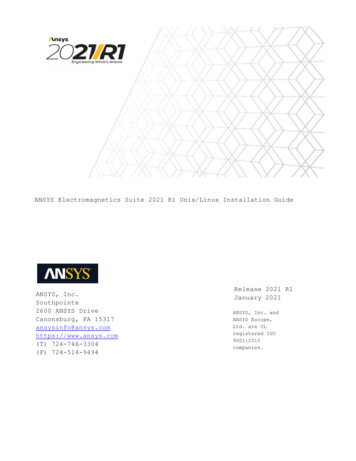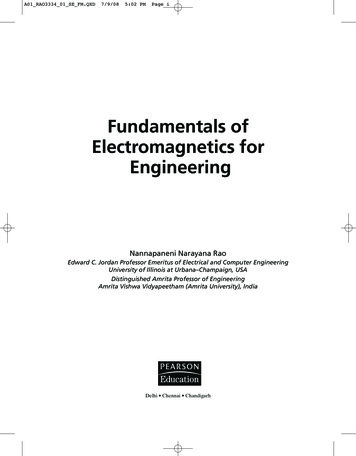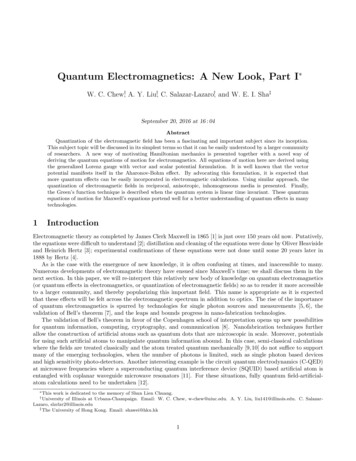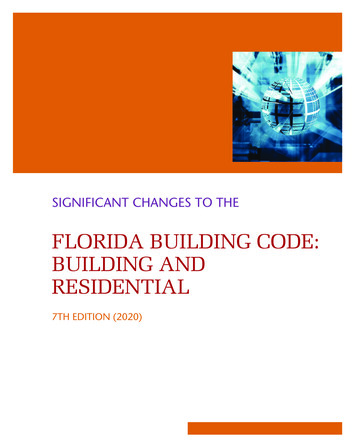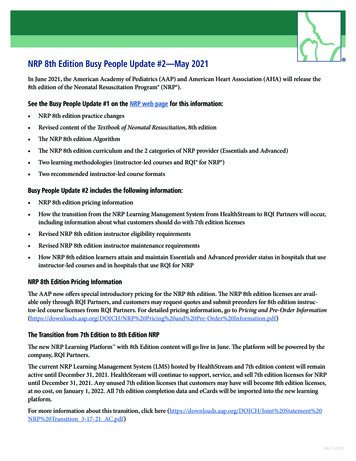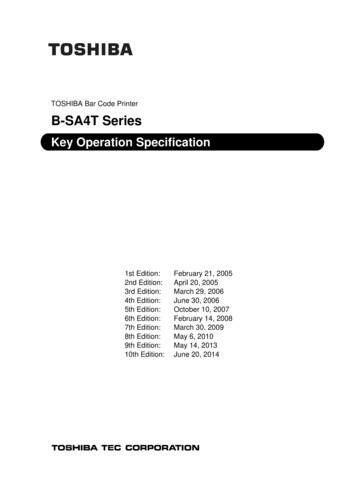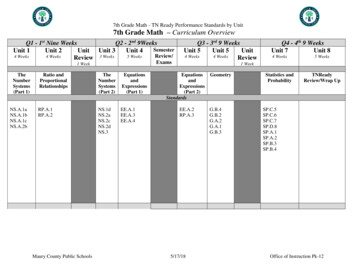
Transcription
Continue
Elements of electromagnetics 7th edition pdf download pdf freeElements of Electromagnetics By Matthew N.O. Sadiku Elements of Electromagnetics is electronics and communication engineering book by Matthew N.O. Sadiku. Using a vectors-first approach, Elements of Electromagnetics, Sixth Edition, explains electrostatics, magnetostatics, fields, waves, and applications like transmission lines, waveguides, andantennas. The book also provides a balanced presentation of time-varying and static fields, preparing students for employment in today’s industrial and manufacturing sectors. Streamlined to facilitate student understanding, Elements of Electromagnetics, Sixth Edition, features worked examples in every chapter that explain how to use the theorypresented in the text to solve different kinds of problems. It also covers numerical methods, including MATLAB and vector analysis, to help students analyze situations that they are likely to encounter in industry practice. Vector algebra — Coordinate systems and transformation — Vector calculus — Electrostatic fields — Electric fields in materialspace — Electrostatic boundary value problems — Magnetostatic fields — Magnetic forces, materials, and devices — Maxwell’s equations — Electromagnetic wave propagation — Transmission lines — Waveguides — Antennas — Numerical methods. The fully revised and updated sixth edition now features: *Fifteen new “Application Notes” thatexplain the connections between concepts discussed in the text and the real world *A math assessment that enables instructors to gauge their students’ mathematical knowledge and preparedness for the course *Coverage of wave polarization (Chapter 10) *New and updated end-of-chapter problems Elements of Electromagnetics PDF Author(s):Matthew N. O. Sadiku Series: The Oxford series in electrical and computer engineering Publisher: Oxford University Press, Year: 2018 ISBN: 9780190698614,0190698616,9780190698676,0190698675 You can download Elements of Electromagnetics 7th Edition by Matthew Sadiku free in pdf format. About BookUsing a vectors-first approach,Elements of Electromagnetics, Seventh Edition, covers electrostatics, magnetostatics, fields, waves, and applications like transmission lines, waveguides, and antennas. The text also provides a balanced presentation of time-varying and static fields, preparing students for employment in today’s industrial and manufacturing sectors.Streamlined tofacilitate student understanding, Elements of Electromagnetics features worked examples in every chapter that explain how to use the theory presented in the text to solve different kinds of problems. It also covers numerical methods, including MATLAB and vector analysis, to help students analyze situations that they are likely to encounter inindustry practice.Download Electromagnetics 7th Edition by Matthew Sadiku 39.99 19.99Download Elements of Electromagnetics (7th Edition) written by Matthew Sadiku in PDF format. This book is under the category Electronics and bearing the isbn/isbn13 number 0190698616; 0190698667; 0190698675/9780190698614/ 9780190698669/9780190698676. You may reffer the table below for additional details of the book. Description Additional information book-authorMatthew SadikupublisherOxford University Press; 7th 0190698616; 0190698667; 0190698675isbn139780190698614/ 9780190698669/ 9780190698676 Using avectors-first method; Sadiku’s Elements of Electromagnetics; seventh Edition; (PDF) contains electrostatics; magnetostatics; waves; fields; and functions like transmission strains; waveguides; and antennas. The textual content additionally gives a balanced presentation of time-various and static fields; getting ready college students for employment inright this moment’s industrial and manufacturing sectors.Streamlined to ease a college pupil’s understanding; Elements of Electromagnetics (The Oxford Series in Electrical and Computer Engineering) options labored examples in every chapter that specify learn how to use the idea offered within the textual content to resolve completely differentsorts of issues. It additionally contains numerical strategies; together with MATLAB and vector evaluation; to assist school college students consider conditions that they’re prone to face in business observe.Reviews“Well-written and easy to follow; with an excellent balance of ease; rigor; and clarity. This ebook has lots of practice problems and anexcellent collection of application notes.” — Sudarshan Nelatury; Pennsylvania State University; Erie“This is one of the top electromagnetics textbooks on the market. With its comprehensible language and strong approach; Elements of Electromagnetics is almost flawless.” — Lili H. Tabrizi; California State University; Los Angeles“Elements ofElectromagnetics offers easy-to-understand explanations without losing the complexity of the material. The solved problems are comprehensive and a good reference for students to practice the theory behind the concepts.” — Sima Noghanian; University of North DakotaNOTE: The product solely contains the ebook Elements of Electromagnetics;seventh Edition in PDF. No access codes are included. July 15, 2021December 20, 2021 Follow my blog with BloglovinAre you also looking for a good structure for your business blogs? That you finally have a serious and good structure for all your texts that are online? On your website but also on social media. In this review you will find 5 tips fromSusanna Florie from her July 13, 2021June 21, 2021 “Why engineering?” is a question I get often. The answer for me is simple: I like to solve problems. Engineering is a popular field for many reasons. Perhaps this is because almost everything around us is created by engineers in one way or another, and there are always new, emerging and excitingtechnologies impacting July 11, 2021December 20, 2021 Not sure how best to study math ? Are you perhaps someone who starts studying the day before the exam? Then you know yourself that your situation is not the most ideal. Unfortunately, there is no magic bullet to make you a maths crack or pass your exam in no time . It is important to knowthat mathematics always builds on Table of contents : Cover.Page 1Inside-Front Cover.Page 2Half-Title.Page 4Series.Page 5Elements Of Electromagnetics.Page 6Copyright.Page 7Dedication.Page 8Brief Table of Contents.Page 9Contents.Page 10Preface.Page 16A Note to The Student.Page 20About TheAuthor.Page 21Math Assessment.Page 22Part 1: Vector Analysis.Page 281 Vector Algebra.Page 302 Coordinate Systems And Transformation.Page 583 Vector Calculus.Page 86Part 2: Electrostatics.Page 1364 Electrostatic Fields.Page 1385 Electric Fields In Material Space.Page 2046 Electrostatic Boundary-ValueProblems.Page 252Part 3: Magnetostatics.Page 3227 Magnetostatic Fields.Page 3248 Magnetic Forces, Materials, And Devices.Page 376Part 4: Waves And Applications.Page 4469 Maxwell’s Equations.Page 44810 Electromagnetic Wave Propagation.Page 50011 Transmission Lines.Page 58012 Waveguides.Page 66013Antennas.Page 71814 Numerical Methods.Page 784Appendix A: Mathematical Formulas.Page 862Appendix B: Material Constants.Page 872Appendix C: Matlab.Page 874Appendix D: The Complete Smith Chart.Page 887Appendix E: Answers To Odd-Numbered Problems.Page 888Index.Page 916Inside-Back Cover.Page 924Citation preview PRACTICAL APPLICATIONS Some of the real-life applications covered in this book are listed in order of appearance. 00 Sadiku FRONTCOVER.indd 2 Applications of electrostatics (Section 4.1) Electrostatic separation of solids (Example 4.3) Electrostaticdischarge (ESD) (Section 4.11) Electrostatic shielding (Section 5.9B) High dielectric constant materials (Section 5.10) Graphene (Section 5.11) NEW Electrohydrodynamic pump (Example 6.1) Xerographic copying machine (Example 6.2) Parallel-plate capacitor, coaxial capacitor, and spherical capacitor (Section 6.5) RF MEMS (Section 6.8) (Chapter12 opener) NEW Ink-jet printer (Problem 6.52) Microstrip lines (Sections 6.7, 11.8, and 14.6) Applications of magnetostatics (Section 7.1) Coaxial transmission line (Section 7.4C) Lightning (Section 7.9) Polywells (Section 7.10) NEW Magnetic resonant imaging (MRI) (Chapter 8 opener) Magnetic focusing of a beam of electrons (Example 8.2, Figure8.2) Velocity filter for charged particles (Example 8.3, Figure 8.3) Inductance of common elements (Table 8.3) Electromagnet (Example 8.16) Magnetic levitation (Section 8.12) Hall effect (Section 8.13) NEW Direct current machine (Section 9.3B) Memristor (Section 9.8) NEW Optical nanocircuits (Section 9.9) NEW Homopolar generator disk(Problem 9.14) Microwaves (Section 10.11) Radar (Sections 10.11 and 13.9) 60 GHz technology (Section 10.12) NEW Bioelectromagnetics (Chapter 11 opener) Coaxial, two-line, and planar lines (Figure 11.1, Section 11.2) Quarter-wave transformer (Section 11.6A) Data cables (Section 11.8B) Metamaterials (Section 11.9) NEW Microwave imaging(Section 11.10) NEW Optical fiber (Section 12.9) Cloaking and invisibility (Section 12.10) NEW Smart antenna (Chapter 13 opener) Typical antennas (Section 13.1, Figure 13.2) Electromagnetic interference and compatibility (Section 13.10) Grounding and filtering (Section 13.10) 16/11/17 2:09 PM Textile antennas and sensors (Section13.11) NEW RFID (Section 13.12) NEW Commercial EM software—FEKO (Section 14.7) NEW COMSOL Multiphysics (Section 14.8) NEW CST Microwave Studio (Section 14.9) NEW PHYSICAL CONSTANTS Approximate Best Experimental Value for Problem Quantity (Units) Symbol Value* Work 1029 36p Permittivity of free space (F/m) eo 8.8541012 Permeability of free space (H/m) Intrinsic impedance of free space (V) Speed of light in vacuum (m/s) Electron charge (C) Electron mass (kg) Proton mass (kg) Neutron mass (kg) Boltzmann constant (J/K) Avogadro number (/kg-mole) Planck constant (J s) Acceleration due to gravity (m/s2) Universal constant of gravitation N (m/kg)2 Electron-volt(J) mo 4p 107 12.6 107 120p ho 376.6 c 2.998 108 3 108 e 1.6022 1019 1.6 1019 me 9.1093 1031 9.1 1031 mp 1.6726 1027 1.67 1027 mn 1.6749 1027 1.67 1027 k 1.38065 1023 1.38 1023 N 6.0221 1023 6 1023 h 6.626 1034 6.62 1034 g 9.80665 9.8 G 6.673 1011 6.66 1011 eV 1.602176 1019 1.6 1019* Values recommended byCODATA (Committee on Data for Science and Technology, Paris). 00 Sadiku FRONTCOVER.indd 3 16/11/17 2:09 PM ELEMENTS OF ELECTROMAGNETICS 00 Sadiku FM.indd 1 16/11/17 3:36 PM THE OXFORD SERIES IN ELECTRICAL AND COMPUTER ENGINEERING Adel S. Sedra, Series Editor Allen and Holberg, CMOS Analog Circuit Design,3rd edition Boncelet, Probability, Statistics, and Random Signals Bobrow, Elementary Linear Circuit Analysis, 2nd edition Bobrow, Fundamentals of Electrical Engineering, 2nd edition Campbell, Fabrication Engineering at the Micro- and Nanoscale, 4th edition Chen, Digital Signal Processing Chen, Linear System Theory and Design, 4th edition Chen,Signals and Systems, 3rd edition Comer, Digital Logic and State Machine Design, 3rd edition Comer, Microprocessor-Based System Design Cooper and McGillem, Probabilistic Methods of Signal and System Analysis, 3rd edition Dimitrijev, Principles of Semiconductor Device, 2nd edition Dimitrijev, Understanding Semiconductor Devices Fortney,Principles of Electronics: Analog & Digital Franco, Electric Circuits Fundamentals Ghausi, Electronic Devices and Circuits: Discrete and Integrated Guru and Hiziroğlu, Electric Machinery and Transformers, 3rd edition Houts, Signal Analysis in Linear Systems Jones, Introduction to Optical Fiber Communication Systems Krein, Elements of PowerElectronics, 2nd edition Kuo, Digital Control Systems, 3rd edition Lathi and Green, Linear Systems and Signals, 3rd edition Lathi and Ding, Modern Digital and Analog Communication Systems, 5th edition Lathi, Signal Processing and Linear Systems Martin, Digital Integrated Circuit Design Miner, Lines and Electromagnetic Fields for EngineersMitra, Signals and Systems Parhami, Computer Architecture Parhami, Computer Arithmetic, 2nd edition Roberts and Sedra, SPICE, 2nd edition Roberts, Taenzler, and Burns, An Introduction to Mixed-Signal IC Test and Measurement, 2nd edition Roulston, An Introduction to the Physics of Semiconductor Devices Sadiku, Elements ofElectromagnetics, 7th edition Santina, Stubberud, and Hostetter, Digital Control System Design, 2nd edition Sarma, Introduction to Electrical Engineering Schaumann, Xiao, and Van Valkenburg, Design of Analog Filters, 3rd edition Schwarz and Oldham, Electrical Engineering: An Introduction, 2nd edition Sedra and Smith, Microelectronic Circuits,7th edition Stefani, Shahian, Savant, and Hostetter, Design of Feedback Control Systems, 4th edition Tsividis, Operation and Modeling of the MOS Transistor, 3rd edition Van Valkenburg, Analog Filter Design Warner and Grung, Semiconductor Device Electronics Wolovich, Automatic Control Systems Yariv and Yeh, Photonics: Optical Electronics inModern Communications, 6th edition Żak, Systems and Control 00 Sadiku FM.indd 2 16/11/17 3:36 PM ELEMENTS OF ELECTROMAGNETICS SEVENTH EDITION MATTHEW N. O. SADIKU Prairie View A&M University New York Oxford OXFORD UNIVERSITY PRESS 00 Sadiku FM.indd 3 16/11/17 3:36 PM Oxford University Press is adepartment of the University of Oxford. It furthers the University’s objective of excellence in research, scholarship, and education by publishing worldwide. Oxford is a registered trade mark of Oxford University Press in the UK and certain other countries. Published in the United States of America by Oxford University Press 198 Madison Avenue,New York, NY 10016, United States of America. 2018, 2015, 2010, 2007, 2000 by Oxford University Press 1994, 1989 by Holt, Rinehart, & Winston, Inc For titles covered by Section 112 of the US Higher Education Opportunity Act, please visit www.oup.com/us/he for the latest information about pricing and alternate formats. All rights reserved.No part of this publication may be reproduced, stored in a retrieval system, or transmitted, in any form or by any means, without the prior permission in writing of Oxford University Press, or as expressly permitted by law, by license, or under terms agreed with the appropriate reproduction rights organization. Inquiries concerning reproductionoutside the scope of the above should be sent to the Rights Department, Oxford University Press, at the address above. You must not circulate this work in any other form and you must impose this same condition on any acquirer. Library of Congress Cataloging-in-Publication Data Names: Sadiku, Matthew N. O., author. Title: Elements ofElectromagnetics / Matthew N.O. Sadiku, Prairie View A&M University. Description: Seventh edition. New York, NY, United States of America : Oxford University Press,[2018] Series: The Oxford series in electrical and computer engineering Identifiers: LCCN 2017046497 ISBN 9780190698614 (hardcover) Subjects: LCSH: Electromagnetism.Classification: LCC QC760 .S23 2018 DDC 537—dc23 LC record available at9 8 7 6 5 4 3 2 1 Printed by LSC Communications, United States of America 00 Sadiku FM.indd 4 16/11/17 3:36 PM To my wife, Kikelomo 00 Sadiku FM.indd 5 16/11/17 3:36 PM BRIEF TABLE OF CONTENTS MATH ASSESSMENT MA-1 Chapter 1 VectorAlgebra 3 Chapter 2 Coordinate Systems and Transformation 31 Chapter 3 Vector Calculus 59 Chapter 4 Electrostatic Fields 111 Chapter 5Electric Fields in Material Space 177 Chapter 6 Electrostatic Boundary-Value Problems 225 Chapter 7 Magnetostatic Fields 297 Chapter 8Magnetic Forces, Materials, and Devices349 Chapter 9 Maxwell’s Equations 421 Chapter 10 Electromagnetic Wave Propagation 473 Chapter 11 Transmission Lines 553 Chapter 12 Waveguides 633 Chapter 13 Antennas 691 Chapter 14 Numerical Methods 757 Appendix A Mathematical Formulas 835 Appendix B Material Constants 845 Appendix C MATLAB 847Appendix D The Complete Smith Chart 860 Appendix E Answers to Odd-Numbered Problems 861 Index 889 vi 00 Sadiku FM.indd 6 16/11/17 3:36 PM CON T EN T S BRIEF TABLE OF CONTENTS vi PREFACExiii A NOTE TO THE STUDENT xvii ABOUT THE AUTHOR xviii MATH ASSESSMENT MA-1 PART 1 : VE CTOR ANALYSIS1 VECTOR ALGEBRA 3 † 2 1.1 1.2 1.3 1.4 1.5 1.6 1.7 1.8 Introduction 3 A Preview of the Book 4 Scalars and Vectors 4 Unit Vector 5 Vector Addition and Subtraction 6 Position and Distance Vectors 7 Vector Multiplication 11 Components of a Vector 16 Summary 23 Review Questions 24 Problems 25 COORDINATE SYSTEMS ANDTRANSFORMATION31 2.1 Introduction 31 2.2 Cartesian Coordinates (x, y, z) 32 2.3 Circular Cylindrical Coordinates (r, f, z) 32 2.4 Spherical Coordinates (r, u, f) 35 2.5 Constant-Coordinate Surfaces 44 Summary 51 Review Questions 52 Problems 54 3 VECTOR CALCULUS 59 3.1 3.2 3.3 Introduction 59 Differential Length,Area, and Volume 59 Line, Surface, and Volume Integrals 66 † Indicates sections that may be skipped, explained briefly, or assigned as homework if the text is covered in one semester. vii 00 Sadiku FM.indd 7 16/11/17 3:36 PM viii CONTENTS 3.4 3.5 3.6 3.7 3.8 †3.9 Del Operator 69 Gradient of a Scalar 71 Divergence of a Vector andDivergence Theorem 75 Curl of a Vector and Stokes’s Theorem 82 Laplacian of a Scalar 90 Classification of Vector Fields 92 Summary 97 Review Questions 98 Problems 100 PART 2 : E L E CTROS TAT ICS 4 ELECTROSTATIC FIELDS 111 4.1 4.2 4.3 4.4 4.5 4.6 4.7 4.8 4.9 4.10 †4.11 5 ELECTRIC FIELDS IN MATERIAL SPACE1775.1 5.2 5.3 5.4 5.5 5.6 †5.7 5.8 5.9 †5.10 5.11 †5.12 00 Sadiku FM.indd 8 Introduction 111 Coulomb’s Law and Field Intensity 112 Electric Fields due to Continuous Charge Distributions 119 Electric Flux Density 130 Gauss’s Law—Maxwell’s Equation 132 Applications of Gauss’s Law 134 Electric Potential 141 Relationship between E andV—Maxwell’s Equation 147 An Electric Dipole and Flux Lines 150 Energy Density in Electrostatic Fields 154 Application Note—Electrostatic Discharge 159 Summary 164 Review Questions 167 Problems 168 Introduction 177 Properties of Materials 177 Convection and Conduction Currents 178 Conductors 181 Polarization inDielectrics 187 Dielectric Constant and Strength 190 Linear, Isotropic, and Homogeneous Dielectrics 191 Continuity Equation and Relaxation Time 196 Boundary Conditions 198 Application Note— Materials with High Dielectric Constant 207 Application Note—Graphene 208 Application Note—Piezoelectrics 210 Summary 214 ReviewQuestions 215 Problems 217 16/11/17 3:36 PM CONTENTS ix 6 ELECTROSTATIC BOUNDARY-VALUE PROBLEMS225 6.1 6.2 †6.3 6.4 6.5 6.6 †6.7 6.8 †6.9 Introduction 225 Poisson’s and Laplace’s Equations 225 Uniqueness Theorem 227 General Procedures for Solving Poisson’s or Laplace’s Equation 228 Resistance andCapacitance 249 Method of Images 266 Application Note—Capacitance of Microstrip Lines 272 Application Note—RF MEMS 275 Application Note—Supercapacitors 276 Summary 280 Review Questions 281 Problems 282 PART 3 : MAG NETOS TAT ICS 7 MAGNETOSTATIC FIELDS 297 7.1 Introduction 297 7.2 Biot–Savart’s Law298 7.3 Ampère’s Circuit Law—Maxwell’s Equation 309 7.4 Applications of Ampère’s Law 309 7.5 Magnetic Flux Density—Maxwell’s Equation 317 7.6 Maxwell’s Equations for Static Fields 319 7.7 Magnetic Scalar and Vector Potentials 320 † 7.8 Derivation of Biot–Savart’s Law and Ampère’s Law 326 † 7.9 Application Note—Lightning328 7.10 Application Note—Polywells 329 Summary 333 Review Questions 335 Problems 338 8 MAGNETIC FORCES, MATERIALS, AND DEVICES349 8.1 8.2 8.3 8.4 8.5 † 8.6 8.7 8.8 8.9 † 8.10 † 8.11 00 Sadiku FM.indd 9 Introduction 349 Forces due to Magnetic Fields 349 Magnetic Torque and Moment 361 A Magnetic Dipole 363Magnetization in Materials 368 Classification of Materials 372 Magnetic Boundary Conditions 376 Inductors and Inductances 381 Magnetic Energy 384 Magnetic Circuits 392 Force on Magnetic Materials 394 16/11/17 3:36 PM x CONTENTS 8.12 8.13 † Application Note—Magnetic Levitation 399 Application Note—SQUIDs 401Summary 405 Review Questions 407 Problems 409 PART 4 : WAVE S AND A PPLIC AT IONS 9 MAXWELL’S EQUATIONS 421 9.1 9.2 9.3 9.4 9.5 † 9.6 9.7 † 9.8 † 9.9 † 9.10 Introduction 421 Faraday’s Law 422 Transformer and Motional Electromotive Forces 424 Displacement Current 433 Maxwell’s Equations in Final Forms 436Time-Varying Potentials 439 Time-Harmonic Fields 441 Application Note—Memristor 454 Application Note—Optical Nanocircuits 455 Application Note—Wireless Power Transfer and Qi Standard 457 Summary 460 Review Questions 461 Problems 463 10 ELECTROMAGNETIC WAVE PROPAGATION473 10.1 10.2 10.3 10.4 10.5 10.610.7 10.8 10.9 † 10.10 † 10.11 10.12 † Introduction 473 Waves in General 474 Wave Propagation in Lossy Dielectrics 480 Plane Waves in Lossless Dielectrics 487 Plane Waves in Free Space 487 Plane Waves in Good Conductors 489 Wave Polarization 498 Power and the Poynting Vector 502 Reflection of a Plane Wave at NormalIncidence 506 Reflection of a Plane Wave at Oblique Incidence 517 Application Note—Microwaves 529 Application Note—60 GHz Technology 534 Summary 537 Review Questions 538 Problems 540 11 TRANSMISSION LINES 553 11.1 11.2 11.3 00 Sadiku FM.indd 10 I ntroduction 553 Transmission Line Parameters 554Transmission Line Equations 557 16/11/17 3:36 PM CONTENTS xi 11.4 11.5 11.6 † 11.7 † 11.8 11.9 11.10 † Input Impedance, Standing Wave Ratio, and Power 564 The Smith Chart 572 Some Applications of Transmission Lines 585 Transients on Transmission Lines 592 Application Note—Microstrip Lines and Characterizationof DataCables 604 Application Note—Metamaterials 612 Application Note—Microwave Imaging 613 Summary 617 Review Questions 618 Problems 621 12 WAVEGUIDES 633 12.1 12.2 12.3 12.4 12.5 12.6 † 12.7 12.8 † 12.9 † 12.10 Introduction 633 Rectangular Waveguides 634 Transverse Magnetic Modes 638 Transverse Electric Modes643 Wave Propagation in the Guide 654 Power Transmission and Attenuation 656 Waveguide Current and Mode Excitation 660 Waveguide Resonators 666 Application Note—Optical Fiber 672 Application Note—Cloaking and Invisibility 678 Summary 680 Review Questions 682 Problems 683 13 ANTENNAS 691 13.1 13.2 13.3 13.413.5 13.6 13.7 † 13.8 † 13.9 † 13.10 † 13.11 13.12 13.13 † 00 Sadiku FM.indd 11 I ntroduction 691 Hertzian Dipole 693 Half-Wave Dipole Antenna 697 Quarter-Wave Monopole Antenna 701 Small-Loop Antenna 702 Antenna Characteristics 707 Antenna Arrays 715 Effective Area and the Friis Equation 725 The Radar Equation 728Application Note—Electromagnetic Interference andCompatibility 732 Application Note—Textile Antennas and Sensors 737 Application Note—Fractal Antennas 739 Application Note—RFID 742 Summary 745 Review Questions 746 Problems 747 16/11/17 3:36 PM xii CONTENTS 14 NUMERICAL METHODS 757 14.1 14.2 14.3 14.414.5 † 14.6 † Introduction 757 ield Plotting 758 F The Finite Difference Method 766 The Moment Method 779 The Finite Element Method 791 Application Note—Microstrip Lines 810 Summary 820 Review Questions 820 Problems 822 APPENDIX A APPENDIX B APPENDIX C APPENDIX D APPENDIX E INDEX 889 00 Sadiku FM.indd12 Mathematical Formulas 835 Material Constants 845 MATLAB 847 The Complete Smith Chart 860 Answers to Odd-Numbered Problems 861 16/11/17 3:36 PM PR EFACE This new edition is intended to provide an introduction to engineering electromagnetics (EM) at the junior or senior level. Although the new edition improves on theprevious editions, the core of the subject of EM has not changed. The fundamental objective of the first edition has been retained: to present EM concepts in a clearer and more interesting manner than other texts. This objective is achieved in the following ways: 1. To avoid complicating matters by covering EM and mathematical concepts simultane ‐ously, vector analysis is covered at the beginning of the text and applied gradually. This approach avoids breaking in repeatedly with more background on vector analysis, thereby creating discontinuity in the flow of thought. It also separates mathematical theorems from physical concepts and makes it easier for the student to grasp the generality ofthose theorems. Vector analysis is the backbone of the mathematical formulation of EM problems. 2. Each chapter opens either with a historical profile of some electromagnetic pioneers or with a discussion of a modern topic related to the chapter. The chapter starts with a brief introduction that serves as a guide to the whole chapter and also linksthe chapter to the rest of the book. The introduction helps the students see the need for the chapter and how it relates to the previous chapter. Key points are emphasized to draw the reader’s attention. A brief summary of the major concepts is discussed toward the end of the chapter. 3. To ensure that students clearly get the gist of the matter, keyterms are defined and highlighted. Important formulas are boxed to help students identify essential formulas. 4. Each chapter includes a reasonable amount of solved examples. Since the examples are part of the text, they are clearly explained without asking the reader to fill in missing steps. In writing out the solution, we aim for clarity rather thanefficiency. Thoroughly worked out examples give students confidence to solve problems themselves and to learn to apply concepts, which is an integral part of engineering education. Each illustrative example is followed by a problem in the form of a Practice Exercise, with the answer provided. 5. At the end of each chapter are ten review questionsin the form of multiple-choice objective items. Open-ended questions, although they are intended to be thought-provoking, are ignored by most students. Objective review questions with answers immediately following them provide encouragement for students to do the problems and gain immediate feedback. A large number of problems are providedand are presented in the same order as the material in the main text. Approximately 20 to 25 percent of the problems in this edition have been replaced. Problems of intermediate difficulty are identified by a single asterisk; the most difficult problems are marked with a double asterisk. Enough problems are provided to allow the instructor to choosesome as examples and assign some as homework problems. Answers to odd-numbered problems are provided in Appendix E. 6. Since most practical applications involve time-varying fields, six chapters are devoted to such fields. However, static fields are given proper emphasis because they are special cases of dynamic fields. Ignorance ofelectrostatics is no longer acceptable xiii 00 Sadiku FM.indd 13 16/11/17 3:36 PM xiv PREFACE because there are large industries, such as copier and computer peripheral manufacturing, that rely on a clear understanding of electrostatics. 7. The last section in each chapter is devoted to applications of the concepts covered in the chapter. Thishelps students see how concepts apply to real-life situations. 8. The last chapter covers numerical methods with practical applications and MATLAB programs. This chapter is of paramount importance because most practical problems are only solvable using numerical techniques. Since MATLAB is used throughout the book, an introduction toMATLAB is provided in Appendix C. 9. Over 130 illustrative examples and 300 figures are given in the text. Some additional learning aids such as basic mathematical formulas and identities are included in Appendix A. Another guide is a special note to students, which follows this preface. NEW TO THE SIXTH EDITION Five new Application Notesdesigned to explain the real-world connections between the concepts discussed in the text. A revised Math Assessment test, for instructors to gauge their students’ mathematical knowledge and preparedness for the course. New and updated end-of-chapter problems. Solutions to the end-of-chapter problems and the Math Assessment, as well asPowerPoint slides of all figures in the text, can be found at the Oxford University Press Ancillary Resource Center. Students and professors can view Application Notes from previous editions of the text on the book’s companion website www.oup.com/us/sadiku. Although this book is intended to be self-explanatory and useful for self-instruction, thepersonal contact that is always needed in teaching is not forgotten. The actual choice of course topics, as well as emphasis, depends on the preference of the individual instructor. For example, an instructor who feels that too much space is devoted to vector analysis or static fields may skip some of the materials; however, the students may use themas reference. Also, having covered Chapters 1 to 3, it is possible to explore Chapters 9 to 14. Instructors who disagree with the vector-calculus-first approach may proceed with Chapters 1 and 2, then skip to Chapter 4, and refer to Chapter 3 as needed. Enough material is covered for two-semester courses. If the text is to be covered in one semester,covering Chapters 1 to 9 is recommended; some sections may be skipped, explained briefly, or assigned as homework. Sections marked with the dagger sign ( † ) may be in this category. ACKNOWLEDGMENTS I thank Dr. Sudarshan Nelatury of Penn State University for providing the new Application Notes and the Math Assessment test. It would notbe possible to prepare this edition without the efforts of Executive Editor Dan Kaveney, Associate Editor Christine Mahon, Assistant Editor Megan Carlson, Marketing Manager David Jurman, Marketing Assistant Colleen Rowe, Production Editor Claudia Dukeshire, and Designer Michele Laseau at Oxford University Press, as well as Susan Brown andBetty Pessagno. 00 Sadiku FM.indd 14 16/11/17 3:36 PM PREFACE xv I thank the reviewers who provided helpful feedback for this edition: Mohammadreza (Reza
industry practice.Download Electromagnetics 7th Edition by Matthew Sadiku 39.99 19.99Download Elements of Electromagnetics (7th Edition) written by Matthew Sadiku in PDF format. This book is under the category Electronics and bearing the isbn/isbn13 number 0190698616; 0190698667; 0190698675/9780190698614/ 9780190698669/ 9780190698676.
